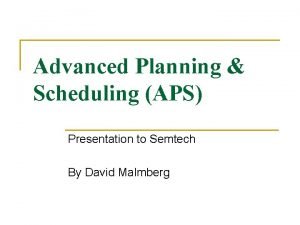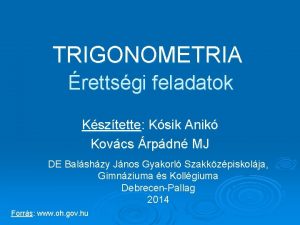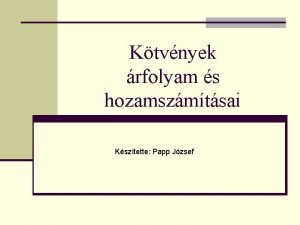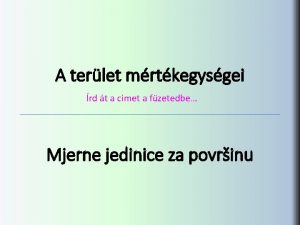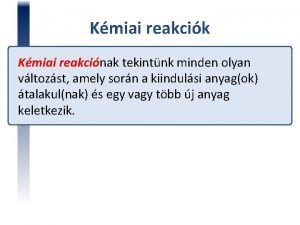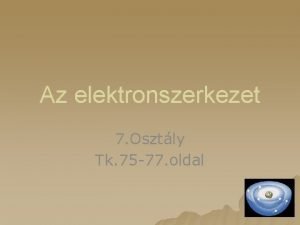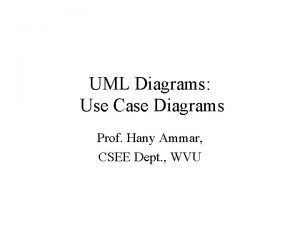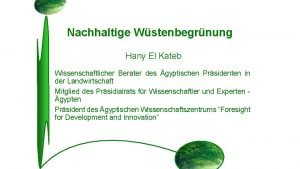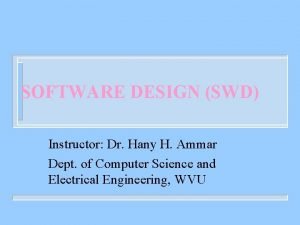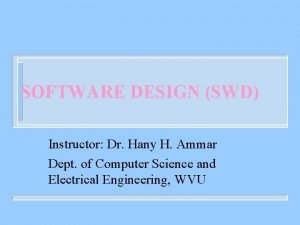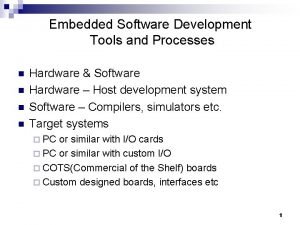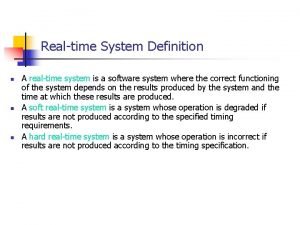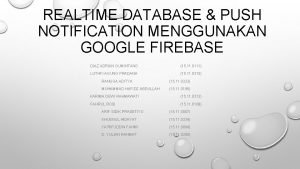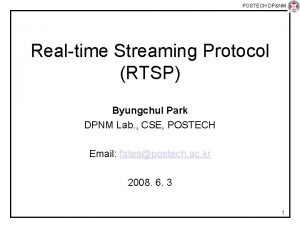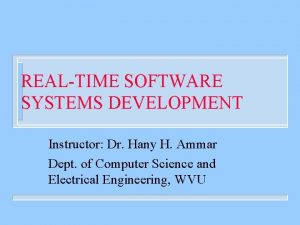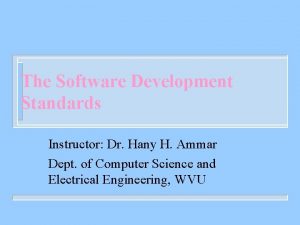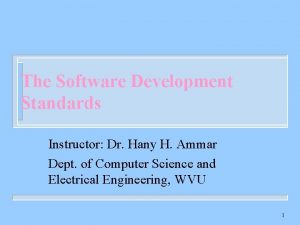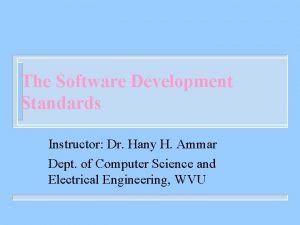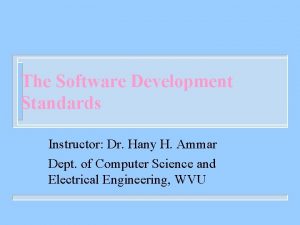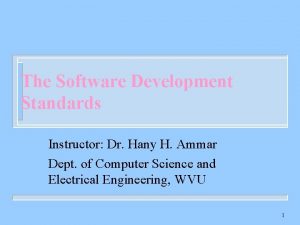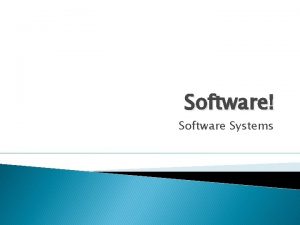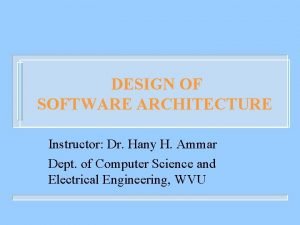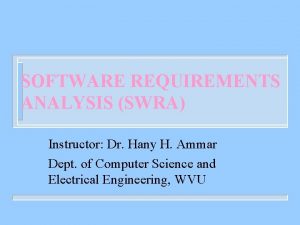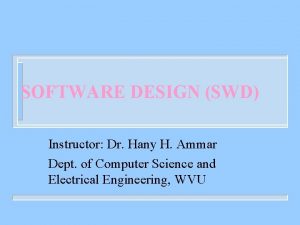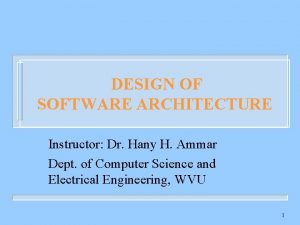REALTIME SOFTWARE SYSTEMS DEVELOPMENT Instructor Dr Hany H















- Slides: 15

REAL-TIME SOFTWARE SYSTEMS DEVELOPMENT Instructor: Dr. Hany H. Ammar Dept. of Computer Science and Electrical Engineering, WVU

Introduction to Real-Time Systems What is a Real-Time System? Is defined as a system in which the time where the outputs are produced is significant (within specified bounds or deadlines). Actuator Outputs Sensor Data Commands RTS Displays Correctness depends on output values and the time at which the inputs are processed and the outputs are produced

Introduction to Real-Time Systems n n n Real-Time Systems can be Hard Real-Time systems or Soft Real-Time systems In Hard Real-Time systems outputs must be produced within the specified deadlines or a system failure will occur (Examples include: Flight Control systems, Air Traffic Control systems, Robots, Automotive Control Systems, . . ) In Soft Real-Time Systems, deadlines can be occasionally missed ( Examples include: communications systems using time out protocols, ATMs, Air line Reservation Systems, Process Control Systems designed to tolerate delays)

Engineering Applications of Real -Time Systems 1. Process Control and Manufacturing Systems Operator Displays Commands Controller Sensor Data Raw Material Control Signals Plant Finished Products

Engineering Applications of Real -Time Systems 2. Integrated Communication, Command, and Control (IC 3) Systems Filtered data/ Controls info Command Comm. Data Control From Signals Decisions Sensing devices/ Control signals to Sensor Data Actuating devices, Control and data to displays

Characteristics of Real-Time Systems • Real-Time systems are often embedded systems (i. e. , contained within a larger system to provide monitoring, control, and computation functions) • They often require concurrent processing of multiple inputs. Concurrent tasks must be created and managed in order to fulfill the functions of the system. • Task scheduling is one of the important aspects of managing concurrency. Since tasks will compete for the same resources (such as the Processor)

Embedded/Concurrent Systems Data/Control BUS Sensor IO Drivers Micro. Controller Sensor HW Plant Actuator control IO Drivers Actuator Control

Characteristics of Real-Time Systems : Task Scheduling Example: two periodic tasks A and B, Ap=10, Ad=20, Bp=25, Ad Bd=50 A will miss its deadline Fixed in the second execution Priority Scheduling 0 10 20 35 B>A Ad Ad Bd Nearest deadline scheduling 0 10 20 30 40 45 55 A B A B B A

Characteristics of Real-Time Systems n n Real-Time systems need to respond to synchronous events ( i. e. , periodic events) as well as asynchronous events (those that could occur at any time) Real-Time systems often require high Reliability and Safety requirements. Real-Time systems often have special environmental, interfacing, and fault-tolerance requirements. Environmental factors such as temperature (e. g. , in space exploration applications systems must operate in a temperature range of -55 to 200 degree centigrade), shock and vibration, size limits, weight limits, usually have an impact on the system hardware and software requirements

Characteristics of Real-Time Systems n Fault-tolerant requirements and Exception handling have special consideration due to the high reliability and critical timing requirements. Fault-tolerance requirements greatly impact and usually complicate the design of software and hardware components of the system. n Interfacing requirements. The devices which are typically interfaced to a RTS are many (Examples include sensors, actuators, switches, displays, communication links, D/A and A/D converters, and pulse-width-modulated controllers)

A CASE STUDY n The functional requirements of an Aircraft Monitoring System (AMS) 1. The system shall perform various aircraft monitoring and recording functions. 2. The aircraft has one engine. the engine is fitted with pressure and temperature sensors. 3. The sensors are polled by the system at regular 1 second intervals. 4. All sensors readings shall be sent to dials, one for each sensor. 5. All sensor readings shall be tested to be within a safe working range.

A CASE STUDY 6. When three consecutive readings from a sensor were found to be out of range, a lamp corresponding to the sensor is changed from green to red. 7. When a sensor fails to respond to a poll sequence, a time out signal is generated. 8. A timed out sensor shall be treated as if it had supplied an out of range reading 9. Three consecutive time outs shall cause a warning lamp to switch from green to red. 10. A number of smoke detectors are installed in the aircraft. When smoke is first detected, an interrupt is generated by the smoke detectors.

A CASE STUDY 11. When smoke is subsequently no longer detected, an interrupt is generated by the smoke detectors. 12 The system shall switch a smoke warning lamp from green to red when a smoke detection interrupt occurs. 13. A sensor is installed in the fuel tank of the aircraft to provide information on the quantity of fuel remaining. 14. The fuel sensor shall be polled and read by the system at 1 second intervals. 15. The fuel sensor reading shall be passed to a dial. 16. A warning lamp shall be switched from green to red when a 10% or less fuel reading is obtained from the fuel sensor.

A CASE STUDY 17. The system shall have the capability to support a CRT display and a keyboard 18. Measures calculated from the sensor data (such as rate of change of pressure, rate of fuel consumption, etc. ) can be requested by the pilot using the keyboard. 19. These measures shall be displayed on the CRT display. 20. Out of limit readings from the sensors or smoke detectors which cause the warning red light to be set shall cause a warning message to be displayed on the CRT. 21 The warnings message shall be of a higher precedence over the measures requested to be displayed By the pilot.

A CASE STUDY 22. The warning messages persist until acknowledged by the pilot via the keyboard. 23. When all warning messages have been acknowledged, the last request shall be displayed. 24. The key board shall be used by the pilot to request the system to simulate the smoke detection. 25. All smoke or no smoke interrupts shall be recorded on a magnetic medium. 26 All readings recorded on the magnetic medium shall be tagged with time at which they were received.
 Realtime aps software
Realtime aps software Trigonometria érettségi feladatok
Trigonometria érettségi feladatok Papp zsombor hány éves
Papp zsombor hány éves Hány szó van a magyar nyelvben
Hány szó van a magyar nyelvben Hány féle aminosav építi fel a fehérjéket
Hány féle aminosav építi fel a fehérjéket Négyzetméter négyzetdeciméter
Négyzetméter négyzetdeciméter Reakcióegyenletek
Reakcióegyenletek Telített elektronhéj
Telített elektronhéj Hany ammar
Hany ammar Hany el kateb
Hany el kateb Hany ammar
Hany ammar Hany ammar
Hany ammar Embedded software tools
Embedded software tools Real-time system definition
Real-time system definition Firebase realtime notification
Firebase realtime notification Realtime streaming protocol
Realtime streaming protocol
